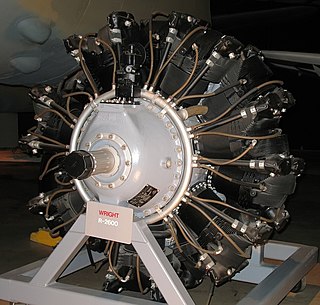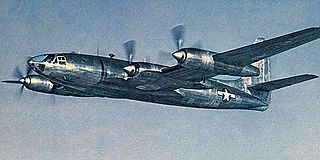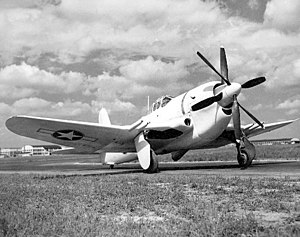
The Curtiss Falcon was a family of military biplane aircraft built by the American aircraft manufacturer Curtiss Aeroplane and Motor Company during the 1920s. Most saw service as part of the United States Army Air Corps as observation aircraft with the designations O-1 and O-11, or as the attack aircraft designated the A-3 Falcon.

The Wright R-3350 Duplex-Cyclone is an American twin-row, supercharged, air-cooled, radial aircraft engine with 18 cylinders displacing nearly 3,350 cubic inches (54.9 L). Power ranged from 2,200 to over 3,700 hp, depending on the model. Developed before World War II, the R-3350's design required a long time to mature before finally being used to power the Boeing B-29 Superfortress. After the war, the engine had matured sufficiently to become a major civilian airliner design, notably in its turbo-compound forms, and was used in the Lockheed L-1049 Super Constellation airliners into the 1990s. The engine is commonly used on Hawker Sea Fury and Grumman F8F Bearcat Unlimited Class Racers at the Reno Air Races. Its main rival was the 4,360 in3 (71.4 L), 4,300 hp (3,200 kW) Pratt & Whitney R-4360 Wasp Major, first run some seven years after the Duplex-Cyclone's beginnings.

The Wright R-2600 Cyclone 14 is an American radial engine developed by Curtiss-Wright and widely used in aircraft in the 1930s and 1940s.

The Republic XF-12 Rainbow was an American four-engine, all-metal prototype reconnaissance aircraft designed by the Republic Aviation Company in the late 1940s. Like most large aircraft of the era, it used radial engines, specifically Pratt & Whitney R-4360 Wasp Major corncob engines. The XF-12 was referred to as "flying on all fours" meaning: four engines, 400 mph (640 km/h) cruise, 4,000 mi (6,400 km) range, at 40,000 ft (12,000 m). The aircraft was designed to maximize aerodynamic efficiency. Although innovative, the jet engine and the end of World War 2 made it obsolete, and it therefore did not enter production.

The Curtiss SBC Helldiver was a two-seat scout bomber and dive bomber built by the Curtiss-Wright Corporation. It was the last military biplane procured by the United States Navy. Delivered in 1937, it became obsolete even before World War II and was kept well away from combat with Axis fighters.

The Boeing XF8B was a single-engine aircraft developed by Boeing during World War II to provide the United States Navy with a long-range shipboard fighter aircraft. The XF8B was intended for operation against the Japanese home islands from aircraft carriers outside the range of Japanese land-based aircraft. Designed for various roles including interceptor, long-range escort fighter, dive-bomber, and torpedo bomber, the final design embodied a number of innovative features in order to accomplish the various roles. Despite its formidable capabilities, the XF8B-1 never entered series production.

The Curtiss XP-62 was a prototype single-engine interceptor aircraft, that was built at the request of the United States Army Air Forces, by the Curtiss-Wright Corporation. It first flew in 1943.

The Grumman XF5F Skyrocket was a prototype twin-engined shipboard fighter interceptor. The United States Navy ordered one prototype, model number G-34, from Grumman Aircraft Engineering Corporation on 30 June 1938; its designation was XF5F-1. The aircraft had a unique appearance: The forward "nose" of the fuselage did not extend forward of the wing. Provisions were included for two 20 mm (0.906 in) Madsen cannon as armament.

The Vultee XP-54 Swoose Goose was a prototype fighter built by the Vultee Aircraft Company for the United States Army Air Forces (USAAF).

The Curtiss F6C Hawk was a late 1920s American naval biplane fighter aircraft. It was part of the long line of Curtiss Hawk airplanes built by the Curtiss Aeroplane and Motor Company for the American military.

The Curtiss F7C Seahawk was a carrier-capable biplane fighter aircraft of the United States Navy Marine Corps in the late 1920s and early 1930s.

The Vought XF2U was a prototype biplane fighter aircraft evaluated by the United States Navy at the end of the 1920s, but was already outclassed by competing designs and never put into production.

The Curtiss Model 55 Kingbird was an airliner built in small numbers in the United States in the early 1930s. It was a twin-engine aircraft with a fuselage derived from the single-engine Curtiss Thrush. The Kingbird had two engine nacelles mounted on the struts on either side of the fuselage that braced the wing and the outrigger undercarriage. A distinctive design feature was the aircraft's blunt nose, located behind the propeller arcs. This allowed the engines to be mounted closer to each other and to the aircraft's centerline, therefore minimising asymmetrical thrust in case of an engine failure. For the same reason, the Thrush's single tailfin was replaced by twin tails on the Kingbird, and the main production model, the D-2 fitted a second horizontal stabilizer and elevator between these fins.

The Curtiss XBTC was a prototype single-seat, single-engined torpedo/dive bomber developed during World War II for the United States Navy. Four aircraft were ordered, powered by two different engines, but the two aircraft to be fitted with the Wright R-3350 radial engine were cancelled in late 1942, leaving only the pair using the Pratt & Whitney R-4360 radial. By this time, Curtiss Aircraft was overwhelmed with work and the Navy gave the XBTC-2 prototypes a low priority which delayed progress so the first flight did not take place until the beginning of 1945. One aircraft crashed in early 1947 and the other was disposed of later that year.

The Curtiss XF15C-1 is a mixed-propulsion fighter prototype of the 1940s. It was among a number of similar designs ordered by the US Navy before pure-jet aircraft had demonstrated their ability to operate from carriers and the mixed-propulsion designs were abandoned. Only three prototypes were constructed, the first one having crashed in testing while the second was scrapped and the last survives to this day.

The Douglas XFD was a carrier-based biplane fighter aircraft designed for the United States Navy, and the first fighter to be built by the Douglas Aircraft Company. A victim of changing requirements, no production was undertaken.
The R-4090 Cyclone 22 was an experimental radial piston engine designed and built in prototype form in the United States during the 1940s.
The Lycoming XH-2470 was an H engine for aircraft designed and developed by Lycoming Engines in the 1930s. Although the engine was flown in an aircraft, it was not fitted to any aircraft selected for production. It was derived from the Lycoming O-1230 engine.

The Hughes XF-11 was a prototype military reconnaissance aircraft designed and flown by Howard Hughes and built by Hughes Aircraft for the United States Army Air Forces. Although 100 F-11s were ordered in 1943, only two prototypes and a mockup were completed. During the first XF-11 flight in 1946, piloted by Hughes himself, the aircraft crashed in Beverly Hills, California. The production aircraft had been canceled in May 1945, but the second prototype was completed and successfully flown in 1947. The program was extremely controversial from the beginning, leading the U.S. Senate to investigate the XF-11 and the Hughes H-4 Hercules flying boat in 1947–1948.

The Berliner-Joyce XF2J was the company's second biplane fighter for the United States Navy. The XF2J was ordered on 30 June 1931 and although designated as a two-seat fighter, it was used as an observation aircraft.


















